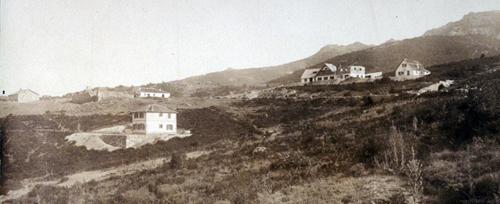El Ventorrillo Biological Station
El Ventorrillo Biological Station
El Ventorrillo Biological Station (EBEV, for its acronym in Spanish) is located in the Sierra de Guadarrama, between the localities of Cercedilla and Navacerrada; it lies at 1,400m above sea level, 60km away from the city of Madrid. The premises consists of two buildings with bedrooms, a living room, kitchen, bathrooms, offices and laboratories. Both buildings are inside a private woodland of ca. 600 hectares with a mixed deciduous and pine forest. There are indoor and outdoor animal facilities, so that animals used in scientific research live in semi-liberty.

The Station was established in 1911 under the name of “Estación Alpina de Biología del Guadarrama” (Guadarrama Alpine Biological Station), and quickly gained an excellent reputation for the quality of the studies that national and international researchers in residence conducted there.
Francisco de las Barras de Aragón was the first Director of El Ventorrillo; the activities at the Biological Station were initiated with his course “Historia Natural de la Sierra de Guadarrama” (Natural History of the Sierra de Guadarrama).
Lines of research
- Evolution and variations in chemical sexual signals of reptiles
- Evolution of birds’ sense of smell.
- Bird coloration and signalling.
- Impact of the chytrid fungus on reproductive function in amphibians.
- Impact of the climate on the incidence of parasitic diseases in birds.
- Acoustic monitoring of terrestrial vertebrates.
- Response of coprophagous beetles to temperature changes.
- Eco systemic services provided by coprophagous beetles.
- Characterization of wild apple tree populations in the Sierra de Madrid.
- Impacts of atmospheric phosphorus and nitrogen depositions on plants and soil microbiome of high mountain ecosystems.
- Development of assessment protocols for changes in moss adaptation to different climate change scenarios.
Services
Use of laboratories, facilities and accommodation
The EBEV facilities offer independent indoor laboratories. Equipment includes cold and hot water and a big private outdoor space for field experiments, animal facilities, and other uses. Refrigerators and freezers can be used to store materials or specimens. Researchers are expected to bring their own specialized equipment. The laboratories and the outdoor spaces are assigned according to the specific needs of the users. Spaces to store the equipment used in a regular research base is also available.
The field station also provides accommodation for the whole year, with a maximum capacity of 15 people. There are 2-bed and 4-bed large dormitories. Visitors are provided with bed linen and towels. The station is also equipped with central heating, a big kitchen, and two large meeting rooms with a fireplace. When necessary, meeting rooms and offices can be moved to different spaces other than the laboratory.
The field station can also host courses, seminars, workshops and other scientific gatherings (limited to a relatively small number of people). There is a large hall with basic audiovisual equipment for this purpose.
Thermal cameras
The EBEV may provide two thermal cameras for experimentation with automatic control of illumination and temperature.
Dissemination

The EBEV is currently a workplace which is not open to the general public, but the dissemination of its project findings is of great importance. For this reason, the National Museum of Natural Sciences has arranged some itinerant exhibitions covering some of these projects and has held scientific symposiums in the villages of the Sierra - more specifically in Cercedilla and Navacerrada - so that locals, visitors, and above all, students, can learn about this ecosystem and the research work that is being carried out in the area.
Ciencia Serrana (Science of the Sierra)
Cycle of scientific symposiums about the research conducted at the EBEV.
Cercedilla and Navacerrada.
Scientist in charge
Juan Antonio Fargallo Evolutionary Ecology Department, MNCN-CSIC.
Documents
- Manual de Usuarios (User manual)
- El rincón científico de la Sierra de Guadarrama (The scientific corner of the Sierra de Guadarrama)
- Memoria 2005 (report)
- Memoria 2006 (report)
- Memoria 2014 (report)
- Memoria 2018 (report)
- Memoria 2019 (report)

